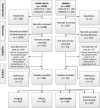Measurement of joint health in persons with haemophilia: A systematic review of the measurement properties of haemophilia-specific instruments
- PMID: 30427100
- PMCID: PMC7379965
- DOI: 10.1111/hae.13631
Measurement of joint health in persons with haemophilia: A systematic review of the measurement properties of haemophilia-specific instruments
Abstract
Introduction: Accurate assessment of joint health in persons with haemophilia is crucial. Several haemophilia-specific measurement tools are available, but an overview of the measurement properties is lacking.
Aim: To provide an overview of the measurement properties of haemophilia-specific measurement tools to assess clinical joint health.
Methods: MEDLINE and EMBASE were searched for reports on reliability, validity or responsiveness of the World Federation of Haemophilia Orthopedic Joint Score (WFH), Colorado Physical Examination Score (CPE), joint examination score by Petrini (PJS) and Hemophilia Joint Health Score (HJHS). Methodological quality of the studies was assessed using an adapted COSMIN checklist.
Results: The search yielded 2905 unique hits, and 98 papers were included. The methodological quality of the included studies was limited. The HJHS was studied most extensively, which yielded limited evidence for good internal consistency and structural validity, moderate evidence for hypothesis testing in adults and conflicting evidence for hypothesis testing in children. Reliability, measurement error and responsiveness were rated unknown due to low COSMIN scores. For the CPE and PJS, we found limited to moderate evidence for good responsiveness and conflicting evidence for hypothesis testing.
Conclusion: Only patchy evidence is available on the quality of measurement properties of all haemophilia-specific joint health scores. Although significant gaps in the evidence for all instruments remain, measurement properties of the HJHS were most extensively studied and show no drawbacks for use in clinical practice. This review forms the basis for further research aimed at the assessment of measurement properties of measurement tools to assess joint health.
Keywords: arthropathy; haemophilia; reliability; responsiveness; validity.
© 2018 The Authors. Haemophilia Published by John Wiley & Sons Ltd.
Conflict of interest statement
SCG has received research funding from Bayer, Baxter, Novo Nordisk and CSL Behring. PH is a member of the International Prophylaxis Study Group (IPSG) Physical Health and Joint Function Expert Working Group. The IPSG is a not for profit collaborative study group supported by grants from Bayer Health care, Bioverativ, CSL‐Behring, NovoNordisk, Pfizer and Shire. VB is Chair of the International Prophylaxis Study Group (IPSG). The IPSG is a not for profit collaborative study group whose mission is to facilitate the acquisition of new knowledge regarding regular replacement therapy (prophylaxis) with clotting factor concentrates in persons with inherited bleeding disorders (focus the hemophilias), and the dissemination of this knowledge globally. The IPSG is supported by grants from Bayer Health care, Bioverativ, CSL‐Behring, NovoNordisk, Pfizer and Shire to the Hospital for Sick Children Foundation, Toronto, Canada. VB does not receive any personal remuneration for his role as Chair of the IPSG. VB has received speaker fees and fees for participation in Advisory Boards from Am, Bayer Healthcare, Novo Nordisk, Pfizer, Roche and Shire. VB is a Co‐Principal Investigator for investigator initiated, industry supported research grants from Bioverativ and Shire. VB is a member of Data Safety Monitoring Boards for Octopharma and Shire. All other authors stated that they had no interests which might be perceived as posing a conflict or bias.
Figures

References
-
- de Moerloose P, Fischer K, Lambert T, et al. Recommendations for assessment, monitoring and follow‐up of patients with haemophilia. Haemophilia. 2012;18:319‐325. - PubMed
-
- Fischer K, Poonnoose P, Dunn AL, et al. Choosing outcome assessment tools in haemophilia care and research: a multidisciplinary perspective. Haemophilia. 2017;23:11‐24. - PubMed
-
- Stephensen D, Drechsler WI, Scott OM. Outcome measures monitoring physical function in children with haemophilia: a systematic review. Haemophilia. 2014;20:306‐321. - PubMed
-
- De Kleijn P, Van Genderen FR, Van Meeteren N. Assessing functional health status in adults with haemophilia: towards a preliminary core set of clinimetric instruments based on a literature search in Rheumatoid Arthritis and Osteoarthritis. Haemophilia. 2005;11:308‐318. - PubMed
-
- De Kleijn P, Heijnen L, Van Meeteren N. Clinimetric instruments to assess functional health status in patients with haemophilia: a literature review. Haemophilia. 2002;8:419‐427. - PubMed
Publication types
MeSH terms
LinkOut - more resources
Full Text Sources
Medical
Research Materials
Miscellaneous

